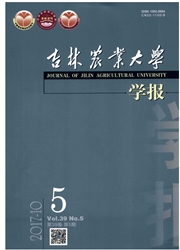

 中文摘要:
中文摘要:
为研究不同杂交组合卡洛斯鹅在不同时期胸肌和腿肌GHR和MSTN基因mRNA的变化规律及与肉用性能的关系,对不同杂交组合卡洛斯鹅于10周时测定其屠宰性能,同时采用实时荧光定量PCR方法检测不同杂交组合鹅0,4,10周胸肌和腿肌中GHR和MSTN基因mRNA的表达水平。结果表明:5组试验鹅腿肌和胸肌中GHR基因的相对表达量均在4周龄达到最大值,且胸肌中的相对表达量高于腿肌,MSTN基因在腿肌中的相对表达量与GHR基因相似;GHR和MSTN基因的相对表达量存在极显著负相关(P〈0.01);GHR基因的相对表达量与宰前活重、屠体重、半净膛重、全净膛重之间均存在极显著正相关(P〈0.01),与腿肌重呈显著正相关(0.01〈P〈0.05);MSTN基因的相对表达量与宰前活重、屠体重、半净膛重、全净膛重、腿肌重均存在极显著负相关(P〈0.01),与胸肌重间呈显著负相关(0.01〈P〈0.05)。GHR和MSTN基因在不同杂交组合鹅的不同生长阶段和不同肌肉组织之间表达量存在差异,与鹅早期肉用性状的表达水平显著相关,可作为鹅早期肉用性状的候选基因。
 英文摘要:
英文摘要:
In order to study the variation of GHR and MSTN genes in breast muscle and leg muscle in different periods, and the correlation between expression levels and meat performance in different hybrid geese, this test measured the slaughter performance of these geese at 10 weeks of age, while quantitative real-time PCR was used to compare the mRNA expression of GHR and MSTN genes in chest and leg muscle at 0, 4 and 10 weeks of age of different hybrid geese. The results were as fol- lows: The expression of GHR in breast meat was peaked in 4 weeks, that of breast muscle was significantly higher than that of leg meat in 5 groups of trial geese, and the trend of the relative expression of the two genes was consistent. The relative expression of GHR and MSTN presented a signifi- cantly negative correlation (P〈0. 01 ) ; The relative expression of GHR gene presented an extremely significantly positive correlation with live weight before slaughter, carcass weight, half eviscerated weight and eviscerated weight (P〈0.01), and a significant positive correlation with leg muscle weight (0. 01 〈P〈0. 05) ; The relative expression of MSTN gene presented a highly significant nega- tive correlation with live weight before slaughter, carcass weight, eviscerated weight, eviscerated weight and leg muscle (P〈0.01), and a significant positive correlation with muscle weight (0. 01 〈 P〈0. 05). Thus, GHR and MSTN levels in different hybrid geese were different in different growth stages and different muscle tissues, and the expression levels of GHR and MSTN genes in early stage were significantly correlated and could be used as candidate genes for early goose meat traits.
 同期刊论文项目
同期刊论文项目
 同项目期刊论文
同项目期刊论文
 期刊信息
期刊信息
